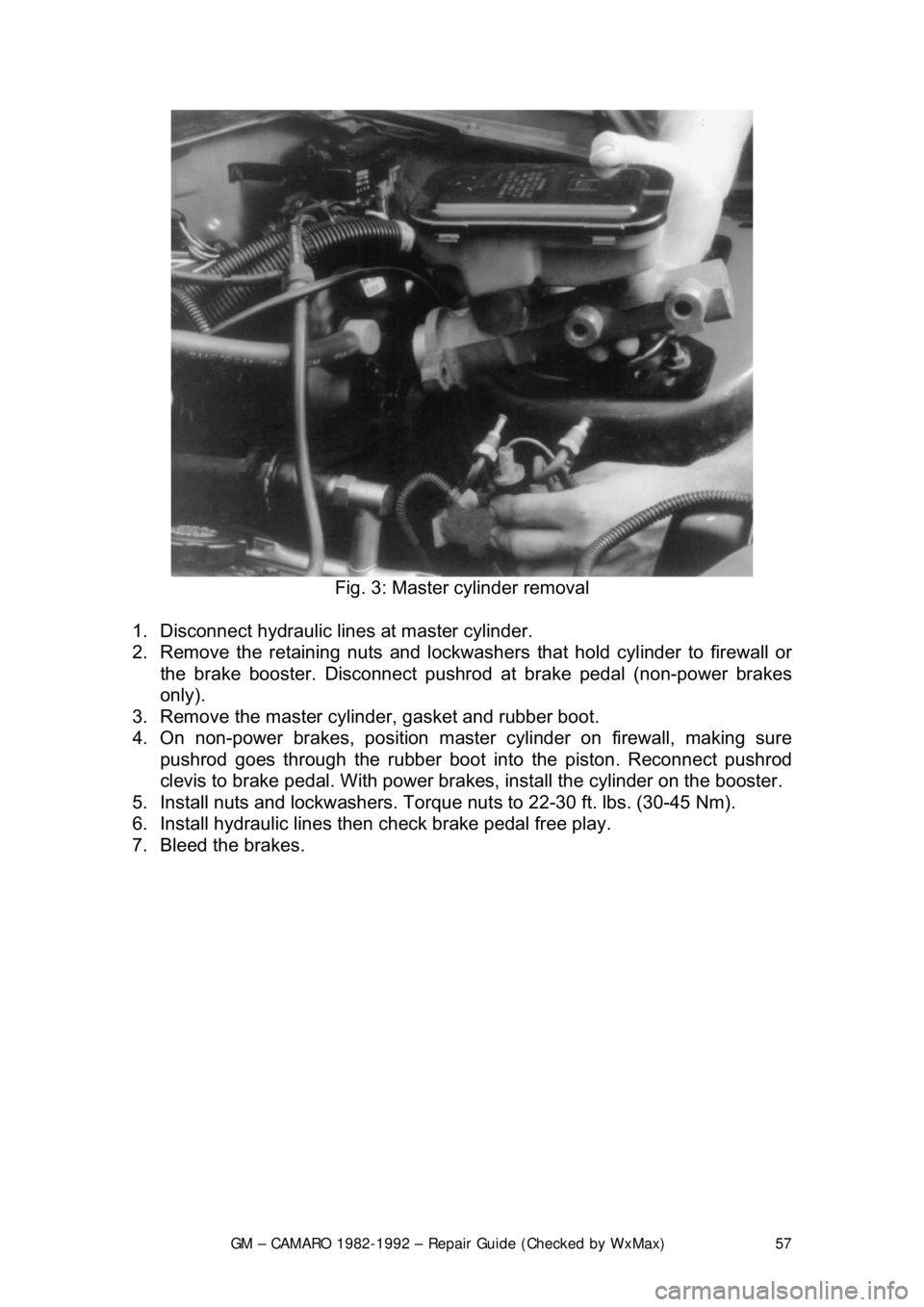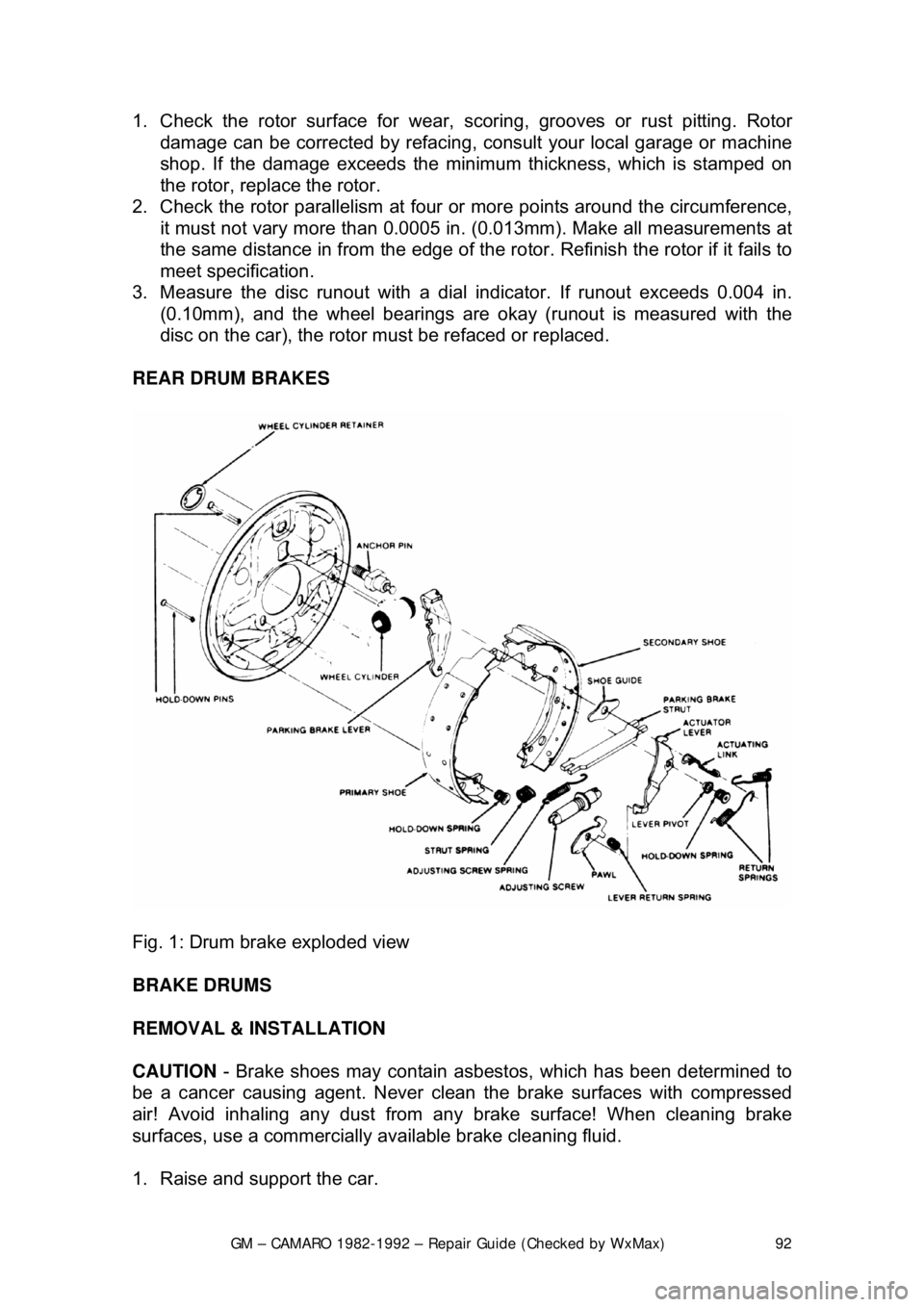1982 CHEVROLET CAMARO brakes
[x] Cancel search: brakesPage 57 of 875

GM – CAMARO 1982-1992 – Repair Guide (Checked by WxMax) 57
Fig. 3: Master cylinder removal
1. Disconnect hydraulic lines at master cylinder.
2. Remove the retaining nuts and lockwasher s that hold cylinder to firewall or
the brake booster. Disconnect pushrod at brake pedal (non-power brakes
only).
3. Remove the master cylinder, gasket and rubber boot.
4. On non-power brakes, position master cylinder on firewall, making sure pushrod goes through the rubber boot in to the piston. Reconnect pushrod
clevis to brake pedal. With power brakes, install the cylinder on the bo\
oster.
5. Install nuts and lockwashers. Torque nut s to 22-30 ft. lbs. (30-45 Nm).
6. Install hydraulic lines t hen check brake pedal free play.
7. Bleed the brakes.
Page 66 of 875

GM – CAMARO 1982-1992 – Repair Guide (Checked by WxMax) 66
4. Remove nuts and lockwashers that se
cure booster to firewall and remove
booster from engine compartment.
5. Install by reversing removal procedure. Make sure to check operation of stop
lights. Allow engine vacuum to build before applying brakes.
COMBINATION VALVE
REMOVAL & INSTALLATION
This valve is not repairable and only serviced as a complete assembly.
1. Disconnect the hydraulic lines from t he valve. Plug the lines to prevent fluid
loss and dirt contamination.
2. Disconnect the electrical connection.
3. Remove the valve.
To install:
4. Position the valve.
5. Connect the electrical connection.
6. Connect the hydraulic lines to the valve.
7. Bleed the brake system.
Page 74 of 875

GM – CAMARO 1982-1992 – Repair Guide (Checked by WxMax) 74
Fig. 2: Master cylinder bleeding
The purpose of bleeding the brakes is to expel air trapped in the hydraulic
system. The system must be bled whenever the pedal feels spongy, indicating
that compressible air has ent ered the system. It must also be bled whenever the
system has been opened, repaired or the fluid appears dirty. You will need a
helper for this job.
CAUTION - Never reuse brake fluid which has been bled from the brake system
1. The sequence for bleeding is right rear , left rear, right front and left front. If
the car has power brakes, remove the vacuum by applying the brakes
several times. Do not run the engine while bleeding the brakes.
2. Clean all the bleeder screws. You ma y want to give each one a shot of
penetrating solvent to loosen it; seiz ure is a common problem with bleeder
screws, which then break off, sometimes requiring replacement of the part to
which they are attached.
3. Fill the master cylinder with good quality brake fluid.
Brake fluid absorbs moisture from the air. Don't leave the master cylinder or the
fluid container uncovered any longer t han necessary. Be careful handling the
fluid; it eats paint. Check the level of the fluid often when bleeding and refill the
reservoirs as necessary. Don't let them run dry or you will have to repeat the
process.
4. Attach a length of clear vinyl t ubing to the bleeder screw on the wheel
cylinder. Submerge the other end of the tube into a clear, clean jar half filled
with brake fluid.
Page 75 of 875

GM – CAMARO 1982-1992 – Repair Guide (Checked by WxMax) 75
5. Have your assistant sl
owly depress the brake pedal. As this is done, open
the bleeder screw 3/4 of a turn and allow the flui d to run through the tube.
Then close the bleeder screw before the pedal reaches the end of its travel.
Have your assistant slo wly release the pedal. Rep eat this process until no
air bubbles appear in the expelled fluid.
6. Repeat the procedure on the other three br akes, checking the level of fluid in
the master cylinder reservoir often.
7. Upon completion, check the brak e pedal for sponginess and the brake
warning light for unbalanced pressure . If necessary, repeat the entire
bleeding procedure.
FRONT DISC BRAKES
CAUTION - Some brake pads contain asbest os, which has been determined to
be a cancer causing agent. Never clean the brake surfaces with compressed
air! Avoid inhaling any dust from any brake surface! When cleaning brake
surfaces, use a commercially available brake cleaning fluid.
BRAKE PADS
CAUTION - Some brake pads contain asbest os, which has been determined to
be a cancer causing agent. Never clean the brake surfaces with compressed
air! Avoid inhaling any dust from any brake surface! When cleaning brake
surfaces, use a commercially available brake cleaning fluid.
INSPECTION
The pad thickness should be inspected ever y time that the tires are removed for
rotation. The outer pad can be checked by looking in each end, which is the
point at which the highest rate of wear occurs. The inner pad can be checked by
looking down through the inspection hole in the top of the caliper. If the
thickness of the pad is worn to within 0.030 in. (0.8mm) of the rivet at either end
of the pad, all the pads should be replaced.
Always replace all pads on both front wheel s at the same time. Failure to do so
will result in uneven braking action and premature wear.
REMOVAL & INSTALLATION
Page 80 of 875

GM – CAMARO 1982-1992 – Repair Guide (Checked by WxMax) 80
4. Remove the mounting bo
lts, if equipped with single piston caliper or the
circlip and pin, if equipped with dual piston ca liper. Inspect the bolts for
corrosion and replace as necessary.
5. Remove the caliper fr om the steering knuckle an d suspend it from the body
of the car with a length of wire. Do not allow the caliper to hang by its hose.
6. Remove the pad retaining springs and remove the pads from the caliper.
7. Remove the plastic sleeves and the rubber bushings from the mounting bolt
holes.
8. Obtain a pad replacem ent kit. Lubricate and install the new sleeves and
bushings with a light coat of silicone grease.
9. Install the retainer spring on the i nboard pad, if equipped with single piston
caliper.
A new spring should be included in the pad replacement kit.
10. Install the new inboard pad into the caliper with the wear sensor at the
leading end of the shoe duri ng forward wheel rotation.
11. Install the outboard pad into the caliper.
12. Use a large pair of slip joint plie rs to bend the outer pad ears down over the
caliper, if equipped with t he single piston caliper.
13. Install the calip er onto the steering knuckle. Tighten the mounting bolts to
21-35 ft. lbs. (28-47 Nm), if equipped. In stall the wheel and lower the car. Fill
the master cylinder to its proper le vel with a good quality brake fluid.
14. Pump the brake pedal slowly a nd firmly 3 times with the engine running
before attempting to move the vehicle; bleed the brakes as required.
BRAKE CALIPER
CAUTION - Some brake pads contain asbest os, which has been determined to
be a cancer causing agent. Never clean the brake surfaces with compressed
air! Avoid inhaling any dust from any brake surface! When cleaning brake
surfaces, use a commercially available brake cleaning fluid.
REMOVAL & INSTALATION
Page 82 of 875

GM – CAMARO 1982-1992 – Repair Guide (Checked by WxMax) 82
Avoid inhaling any dust from
any brake surface! When cleaning brake surfaces,
use a commercially available brake cleaning fluid.
1. Remove
2/3 of the brake fluid from the mast er cylinder. Raise the vehicle and
remove the wheel.
2. Place a C-clamp across the caliper, positioned on the brake pads. Tighten it
until the piston is forced into its bore.
3. Remove the C-clamp. Remove the bolt holding the brake hose to the caliper.
4. Remove the Allen head caliper mounting bolts. Inspect them for corrosion
and replace them if necessary. Remove the caliper.
To install:
5. Position the caliper with the brake pad installed and install Allen head caliper
mounting bolts. Mounting bo lt torque is 21-35 ft. lbs. (28-47 Nm.) for the
caliper.
6. Install the bolt holding the brake hos e to the caliper and tighten to 18-30 ft.
lbs. (24-40 Nm.).
7. Fill the master cylinder with brake fluid.
8. Install the wheels and lower the vehicle.
CAUTION - Before moving the vehicle, pump the brakes several times to seat
the brake pad against the rotor
OVERHAUL
Some vehicles may be equipped dual piston calipers. The procedure to
overhaul the caliper is e ssentially the same with t he exception of multiple
pistons, O-rings and dust boots.
1. Remove the caliper from the ve hicle and place on a clean workbench.
CAUTION - NEVER place your finger s in front of the pistons in an attempt to
catch or protect the pistons when applying compressed air. This could result in
personal injury!
Depending upon the vehicle, there are two different ways to remove the piston
from the caliper. Refer to the brake pad replacement procedure to make sure
you have the correct procedure for your vehicle.
2. The first method is as follows: a. Stuff a shop towel or a block of wood into the caliper to catch the piston.
b. Remove the caliper piston using co mpressed air applied into the caliper
inlet hole. Inspect the piston for scor ing, nicks, corrosion and/or worn or
damaged chrome plating. The piston mu st be replaced if any of these
conditions are found.
Page 92 of 875

GM – CAMARO 1982-1992 – Repair Guide (Checked by WxMax) 92
1. Check the rotor surface for wear, sco
ring, grooves or rust pitting. Rotor
damage can be corrected by refacing, cons ult your local garage or machine
shop. If the damage exceeds the minimu m thickness, which is stamped on
the rotor, replace the rotor.
2. Check the rotor parallelism at four or more points around the circumference,
it must not vary more than 0.0005 in . (0.013mm). Make all measurements at
the same distance in from the edge of the ro tor. Refinish the rotor if it fails to
meet specification.
3. Measure the disc runout with a dial indicator. If runout exceeds 0.004 in.
(0.10mm), and the wheel bearings are okay (runout is measured with the
disc on the car), the rotor must be refaced or replaced.
REAR DRUM BRAKES
Fig. 1: Drum brake exploded view
BRAKE DRUMS
REMOVAL & INSTALLATION
CAUTION - Brake shoes may contain asbest os, which has been determined to
be a cancer causing agent. Never clean the brake surfaces with compressed
air! Avoid inhaling any dust from any brake surface! When cleaning brake
surfaces, use a commercially available brake cleaning fluid.
1. Raise and support the car.
Page 93 of 875

GM – CAMARO 1982-1992 – Repair Guide (Checked by WxMax) 93
2. Remove the wheel or wheels.
3. Pull the brake drum off. It may be nec
essary to gently tap the rear edges of
the drum to start it off the studs.
4. If extreme resistance to removal is encountered, it will be necessary to
retract the adjusting screw. Knock out the access hole in the backing plate
and turn the adjuster to retract th e linings away from the drum.
5. Install a replacement hole co ver before reinstalling drum.
6. Install the drums in the same position on the hub as removed.
DRUM INSPECTION
1. Check the drums for any cracks, scores, grooves, or an out-of-round
condition. Replace if cracked. Slight scores can be removed with fine emery
cloth while extensive scoring requires turning the drum on a lathe.
2. Never have a drum turned mo re than 0.060 in. (1.524mm).
BRAKE SHOES
ADJUSTMENT
Rotate the star wheel adjuster until a sl ight drag is felt between the shoes and
drum, then back off 12 clicks on the adjusting wheel. Put the car in reverse and,
while backing up, apply the brakes seve ral times. This will allow the self-
adjusters to complete the adjustment.
REMOVAL & INSTALLATION
Fig. 1: Drum brake assembly